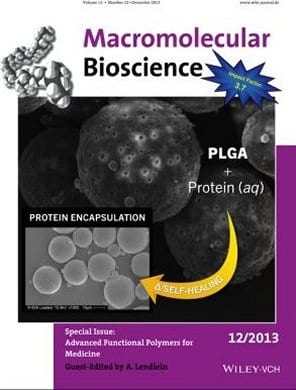 The complex requirements of modern medicine demand a variety of multifunctional materials. Polymers provide a versatile toolbox for such materials. Hydrolytically degradable polymers show temporal changes of mechanical properties during degradation and controlled drug release capabilities, while stimuli-sensitive polymers enable a non-invasive external stimulus to trigger a change in a material property in vivo. Polymers can be designed to mimic the extracellular matrix or scaffold systems for mesenchymal stem cells.
The complex requirements of modern medicine demand a variety of multifunctional materials. Polymers provide a versatile toolbox for such materials. Hydrolytically degradable polymers show temporal changes of mechanical properties during degradation and controlled drug release capabilities, while stimuli-sensitive polymers enable a non-invasive external stimulus to trigger a change in a material property in vivo. Polymers can be designed to mimic the extracellular matrix or scaffold systems for mesenchymal stem cells.
In this topical issue of Macromolecular Bioscience (guest-edited by Andreas Lendlein, Benjamin F. Pierce, Luigi Ambrosio, and Dirk W. Grijpma), several promising approaches taken by chemists and their interdisciplinary collaborations with cell biologists, clinicians, physicists, material engineers, in realizing such materials are presented.
Get FREE ACCESS now to selected articles of this issue!
The editorial by Andreas Lendlein et al. presents a nice overview of the content of the issue.
Supramolecular polymers allow for a modular approach to bioactive biomaterials. Patricia Y. W. Dankers and co-workers (Eindhoven University of Technology, The Netherlands) investigate the effect of processing parameters on the bioactivation of supramolecular biomaterials using an RNase S assay.
Colloidal materials based on thermo-responsive polymers offer a means to transport drugs selectively into tumor tissues. Cameron Alexander and co-workers provide a state-of-the-art overview of these materials and the use of hyperthermia in common anticancer treatment.

















